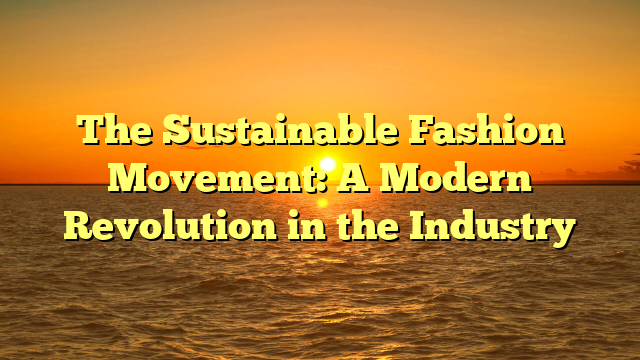
The fashion industry, long celebrated for its creativity and innovation, has also faced criticism for its environmental impact. Fast fashion, characterized by mass production, low costs, and rapid turnover of trends, has fueled overconsumption and waste. However, the rise of the sustainable fashion movement marks a turning point. With increasing awareness of the industry’s ecological footprint, consumers, designers, and brands are championing a shift toward sustainability and environmental responsibility.
Sustainable fashion is rooted in the principle of minimizing harm to the environment while promoting ethical practices. This includes using eco-friendly materials, reducing waste, and ensuring fair labor practices throughout the supply chain. Natural fibers such as organic cotton, hemp, and bamboo have gained popularity as alternatives to synthetic fabrics like polyester, which are derived from petroleum and contribute to pollution. Similarly, recycled materials, such as reclaimed fabrics and plastic bottles transformed into textiles, highlight the industry’s innovative strides toward sustainability.
One of the driving forces behind this movement is the growing consumer demand for transparency. Today’s shoppers are more informed and conscious of their purchasing decisions. Labels like “sustainable,” “ethical,” and “eco-friendly” resonate with a generation that values environmental stewardship. Tools like blockchain technology have further enabled consumers to trace the origins of their clothing, ensuring accountability and fostering trust between brands and their customers.
Designers and brands have also embraced the concept of circular fashion. Unlike samosir88 of “take, make, waste,” circular fashion focuses on designing clothes that can be reused, recycled, or biodegraded. Rental platforms like Rent the Runway and resale apps like ThredUp and Poshmark exemplify this shift, offering consumers alternatives to traditional ownership. These innovations not only extend the lifecycle of garments but also reduce the demand for new production.
Slow fashion, another facet of the sustainable movement, encourages mindful consumption. Unlike fast fashion’s emphasis on quantity and speed, slow fashion prioritizes quality and timeless design. Brands like Patagonia and Stella McCartney have pioneered this approach, advocating for durable clothing that lasts and providing repair services to extend the life of their products.
The rise of sustainable fashion has also been fueled by influential voices in the industry. Celebrities, activists, and designers use their platforms to promote eco-consciousness. The “Green Carpet Challenge,” founded by Livia Firth, encourages designers to create sustainable pieces for high-profile events, showcasing that style and sustainability can coexist.
Despite these advancements, challenges remain. Sustainable materials and ethical production often come at higher costs, making eco-friendly fashion less accessible to all consumers. Additionally, greenwashing—where brands falsely claim to be sustainable—poses a barrier to genuine progress.
However, the momentum of the sustainable fashion movement cannot be denied. Governments, NGOs, and consumers are increasingly holding brands accountable for their environmental impact. Policies promoting sustainability, such as the European Union’s Green Deal, aim to regulate and incentivize eco-friendly practices in the industry.
As awareness continues to grow, the future of fashion lies in its ability to balance creativity with responsibility. The sustainable fashion movement represents more than a trend—it is a modern revolution reshaping the industry for the better. By embracing this change, the fashion world can create a more ethical, equitable, and environmentally conscious future.









